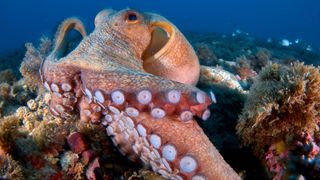
Octopuses are brainy creatures with sophisticated smarts, and now scientists have uncovered a clue that may partly explain the cephalopods' remarkable intelligence: Its genes have a genetic quirk that is also seen in humans, a new study finds.
The clues that scientists uncovered are called "jumping genes," or transposons, and they make up 45% of the human genome. Jumping genes are short sequences of DNA with the ability to copy and paste or cut and paste themselves to another location in the genome, and they've been linked to the evolution of genomes in multiple species. Genetic sequencing recently revealed that two species of octopus — Octopus vulgaris and Octopus bimaculoides — also have genomes that are filled with transposons, according to a study published May 18 in the journal BMC Biology.
In both humans and octopuses, most transposons are dormant, either shut down due to mutations or blocked from replicating by cellular defenses, the study authors reported. But one kind of transposon in humans, known as the Long Interspersed Nuclear Elements or LINE, may still be active. Evidence from prior studies suggests that LINE jumping genes are tightly regulated by the brain, but are still important for learning and for memory formation in the hippocampus.
When the scientists took a closer look at octopus jumping genes that could freely copy and paste around the genome, they discovered transposons from the LINE family. This element was active in the octopus's vertical lobe — a brain section in octopuses that is critical for learning and is functionally analogous to the human hippocampus, Graziano Fiorito, study coauthor and a biologist at the Anton Dohrn Zoological Station (SZAD) in Naples, Italy, told Live Science.
Related: Octopuses torture and eat themselves after mating. Science finally knows why.
In the new study, the researchers measured one octopus transposon's transcription to RNA and translation to protein, and they detected significant activity in areas of the brain related to behavioral plasticity — how organisms change their behavior in response to different stimuli. "We were very happy because this is a sort of proof," said study coauthor Giovanna Ponte, a researcher in the SZAD Department of Biology and Evolution of Marine Organisms.
Even though octopuses aren't closely related to animals with backbones, they nonetheless demonstrate behavioral and neural plasticity that's similar to that of vertebrates, Fiorito added. "These animals, like mammals, have the ability to adapt continuously and solve problems," and this evidence hints that the similarity may originate at the genetic level, he said.
These findings not only connect jumping genes to octopus' intelligence, they also suggest that LINE transposons do more than just jump around. Rather, they have some role in cognitive processing, the authors suggested in a statement. Because jumping genes are shared by humans and octopuses, they may be good candidates for future research on intelligence and how it develops and varies between individuals within a species, according to the study.
However, since octopuses are quite distant from humans on the tree of life, it's possible that active LINE transposons in the two groups are an example of convergent evolution. This means their contribution to intelligence evolved separately in the two lineages, rather than originating in a shared ancestor, the scientists reported.
Originally published on Live Science.












